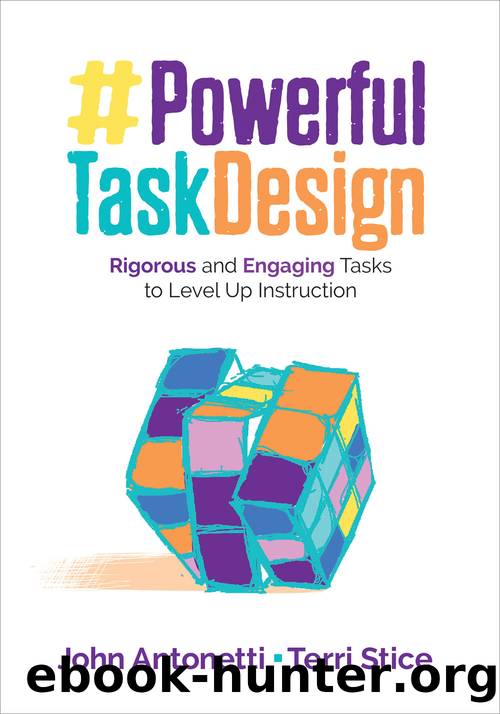Powerful Task Design by John Antonetti & Terri Stice

Author:John Antonetti & Terri Stice
Language: eng
Format: epub
Publisher: SAGE Publications
Published: 2019-06-08T20:19:18.680699+00:00
Figure 4.14 A Trapezoid and a Rhombus
TRUST THE LEARNERS!
Name the Thinking! There is one more consideration to keep the task strategy rigorous: The teacher must make certain that students capture the naming of the patterns, truths, or attributes they find. This naming of the thinking in this strategy leads to concept attainment and vocabulary development.
Letâs go back in time and look at the concept attainment model. Based upon the work of Jerome Bruner (Bruner, Goodnow, & Austin, 2009), concept attainment is an indirect instructional strategy of Generating and Testing Hypotheses. Teachers plan for the seeing and naming of a concept, but do not direct learners to see it or point out what they are seeing. Students are tasked with figuring out the common attributes of a group or category or content by comparing and contrasting examples and nonexamples.
A kindergarten classroom might have a collection to consider that includes a hermit crab, a roly-poly (isopod), and a worm. The nonexamples might include a rock, a drinking straw, and a crayon. As the students brainstorm a list of commonalities amongst members of the example group, they may hypothesize that the group is living things, things that can move, or things you find under rocks. All of these are plausible hypotheses and exhibit analysis of commonalities.
It is then the teacherâs responsibility (and privilege) to be fully present and prepared enough to provide more examples and nonexamples to clarify the plausible hypotheses to the concept she needs to reach. Simply forcing the learners to consider that a ship is another nonexample allows them to eliminate the things that can move and things you find under a rock. To further the testing of the remaining hypothesis, as well as bring more richness to the concept at hand, the class is then tasked with coming up with more examples of living things as well as nonexamples.
It is interesting to note that the same collection of creatures can be presented in an upper-grade science class to elicit the concept of invertebrates. The inability to actually see the absence of a backbone may cause students to struggle more to figure out the missing attribute, especially when the nonexamples are presented. Obviously, the nonexample set would be quite different from the set used in our kindergarten example.
In essence, Generating/Testing Hypotheses is finding patterns of similarity and checking for consistency within the group. We have found in classrooms two very important design considerations in planning these tasks: The original pattern set should consist of exactly three examples before including more examples. And those examples should look as different as possible while still retaining the essential attribute or concept. This allows the learners to compare two members of the group for an initial finding and then check it against the third as a safety test before the idea is articulated. The gradual addition of more examples keeps the brain from being overwhelmed while still demanding testing and reconfirmation of the original hypothesis, or revision to include the new information.
Download
This site does not store any files on its server. We only index and link to content provided by other sites. Please contact the content providers to delete copyright contents if any and email us, we'll remove relevant links or contents immediately.
The Art of Coaching Workbook by Elena Aguilar(50963)
Trainspotting by Irvine Welsh(21517)
Twilight of the Idols With the Antichrist and Ecce Homo by Friedrich Nietzsche(18501)
Fangirl by Rainbow Rowell(9094)
Periodization Training for Sports by Tudor Bompa(8168)
Change Your Questions, Change Your Life by Marilee Adams(7633)
This Is How You Lose Her by Junot Diaz(6778)
Asking the Right Questions: A Guide to Critical Thinking by M. Neil Browne & Stuart M. Keeley(5631)
Grit by Angela Duckworth(5512)
Red Sparrow by Jason Matthews(5390)
Paper Towns by Green John(5086)
Room 212 by Kate Stewart(5035)
Ken Follett - World without end by Ken Follett(4643)
Housekeeping by Marilynne Robinson(4329)
The Sports Rules Book by Human Kinetics(4288)
Double Down (Diary of a Wimpy Kid Book 11) by Jeff Kinney(4204)
Papillon (English) by Henri Charrière(4195)
The Motorcycle Diaries by Ernesto Che Guevara(4009)
Exercise Technique Manual for Resistance Training by National Strength & Conditioning Association(3955)
